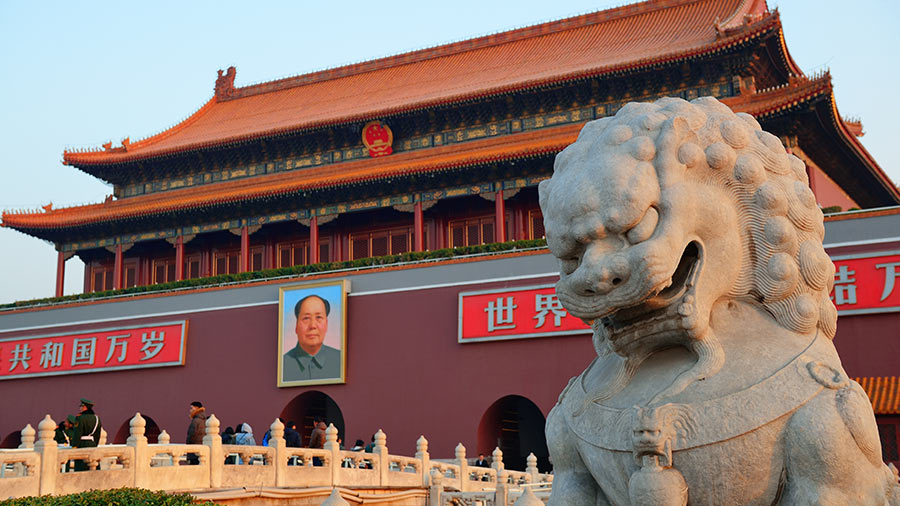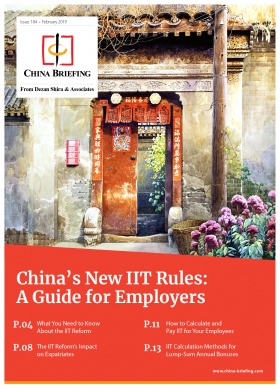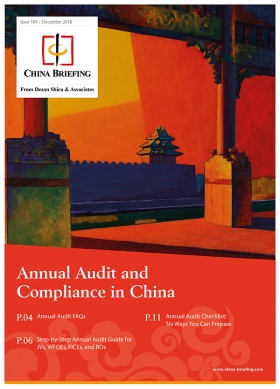China’s 2019 Work Report: Growth Target, Tax Cuts Announced

Every year, China’s premier delivers a Work Report at the Two Sessions meetings, which acts as a policy agenda for the coming year. Here, China Briefing delves into the details and impacts of the 2019 Work Report.
On March 5, Chinese Premier Li Keqiang stood in the Great Hall of the People to deliver the annual Work Report, outlining the country’s policy priorities for the coming year.
The Work Report is a fixture of the Two Sessions, which in most years is China’s biggest political event. Although the Work Report and the Two Sessions are tightly scripted, they are closely watched by analysts looking for hints of China’s policy direction.
This year, the Work Report has attracted extra attention given China’s slowing economy and ongoing trade war with the US. Indeed, in his speech Li said that it was a “crucial year” for the economy and that “China must be fully prepared for a tough struggle.”
In the end, Li delivered a report that was light on surprises and laid out a continuation of the leadership’s strategy to overcome short-term economic challenges.
Here, we look at what the Work Report pledged for China’s economic performance and reform in 2019.
GDP growth target lowered
One of the most closely scrutinized parts of the Work Report is the announcement of the country’s GDP growth target for the coming year.
As expected, Li announced that China would have a growth target of 6-6.5 percent for 2019, down from “around 6.5 percent” last year. Li also confirmed that China’s GDP grew by 6.6 percent in 2018.
The 6-6.5 percent target, rather than a higher and more specific target, reflects China’s slowing economy and the uncertainty in outcomes it faces.
Nevertheless, while the GDP growth target is always at the focus of media attention, analysts have long downplayed its importance.
After years of rapid growth, China’s GDP is growing from a much higher base each year and slowing growth is a natural consequence of a maturing economy. Further, many economists argue that GDP is not a particularly useful gauge of a country’s economic health to begin with – and that is without considering the much-disputed accuracy of China’s official statistics.
Nevertheless, the growth target sets a barometer for China’s economic performance not only to outside observers and investors, but also to regional governments and lenders.
A lower and less-specific target might offer the government more flexibility in pursuing structural reforms and implementing its debt de-risking campaign compared to a more concrete and aspirational figure. This year, Li also did not announce any targets for growth in retail sales or fixed asset investment.
In the face of sliding confidence in the economy and international trade tensions, however, Chinese economic planners may still need to resort to short-term stimulus measures to meet the target – which is still high by most countries’ standards.
VAT, cost cuts, and stimulus
The employment rate is one alternative indicator to GDP growth that economic planners have put added emphasis on in recent months due to its importance for maintaining social stability. In this area, Li said that China aims to create at least 11 million new urban jobs in 2018 while maintaining the urban unemployment rate below 4.5 percent.
To keep unemployment low, Li announced an array of cost cutting measures to ease burdens for businesses. According to Li, these policies will cut costs for businesses by nearly RMB 2 trillion (US$298.3 billion).
Chief among these is a reduction of value-added tax (VAT) rates that will come into effect April 1, 2019:
- The 16 percent VAT rate, which applies to the manufacturing sector, will be lowered to 13 percent;
- The 10 percent rate, which applies to construction and transport, will be lowered to nine percent; and
- The six percent rate, which applies to services, will remain the same, but more deductions for the bracket will be introduced.
Li also said that the government will continue to explore simplifying the VAT system from three rates to two.
In addition to lowering VAT, China will also reduce social insurance costs for employers. Depending on the discretion of local governments, the pension contribution rate for employers may be lowered to 16 percent.
Further, the CIT incentives available to western regions in China will continue beyond their planned expiry date, and the price for commercial power usage will be lowered by 10 percent.
Besides cost cutting, to boost growth, the government announced RMB 577.6 billion (US$86.12 billion) in infrastructure investment, an increase of RMB 40 billion (US$5.96 billion) compared to last year.
As well, the government raised the local governments’ special bond issuance quota from RMB 1.35 trillion (US$201.3 billion) to RMB 2.15 trillion (US$320.8 billion).
Although Li announced various cost cutting and stimulus measures, he emphasized that wide-ranging stimulus – which China resorted to amid the 2008 global financial crisis – will not be coming. “Facing new circumstances and developments, we were firm in choosing not to adopt a deluge of strong stimulus policies,” Li said.
Overall, the government aims for a 2019 budget deficit of 2.8 percent of GDP, up from a 2.6 percent target last year.
Reform and opening
In his speech, Li pledged, “We will keep using market-oriented reforming thinking.” However, Li offered little in terms of concrete reform and market opening measures.
Li said that more sectors will be opened to foreign investment, and that a new encouraged list for foreign investment will be released. He also said that the Shanghai Free Trade Zone – where market reforms are often piloted – will be further expanded in 2019.
This does not necessarily constitute a new promise but is a repetition of previous pledges to further open the economy to foreign investment.
Notably missing from the Work Report, however, was mention of Made in China 2025. Previously, the Made in China 2025 industrial policy and goal to achieve technological self-sufficiency were emphasized by China’s leaders as among the country’s top priorities.
Since entering a trade war with the US, where issues of emerging technology and protectionism of high-tech industries has been a key point of contention, Chinese leaders and media have downplayed Made in China 2025.
Despite this, the policy appears to be largely going ahead, though with less promotion. A separate government budget released on the same day said that the science and technology budget would be RMB 354.31 billion (US$52.88 billion), an increase of 13.4 percent year-on-year.
The ongoing trade war with the US might also explain why other reform and opening measures were not announced in the Work Report.
China might be preparing to offer measures like the further opening of the auto and financial sector to foreign investment and cutting of tariffs of foreign products as concessions in negotiations with the US, and thus Li had no incentive to make pledges in these areas before a deal is reached.
Thus, the Work Report acts as a reiteration and continuation of China’s current economic strategy, which is defined by cutting taxes, costs and red tape combined with measured stimulus, while not abandoning important policies like debt de-risking.
Those looking for new developments regarding foreign investment and trade, however, may need to wait for the completion of a US-China trade deal.
About Us
China Briefing is produced by Dezan Shira & Associates. The firm assists foreign investors throughout Asia from offices across the world, including in Dalian, Beijing, Shanghai, Guangzhou, Shenzhen, and Hong Kong. Readers may write china@dezshira.com for more support on doing business in China.
- Previous Article US Businesses in China Grow Despite Recent Tensions: AmCham China 2019 Survey
- Next Article China Bans Questions on Marital, Childbearing Status during Hiring







